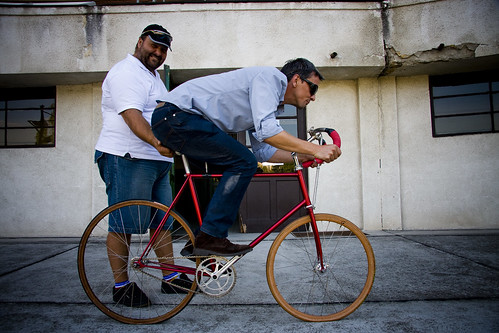

On a visit to Budapest last week I was taken on a tour of the oldest velodrome in Europe that is still in use. Millenáris in Budapest, from 1896. It was fantastic to hear the entire history of the place from the chap behind the bike above, Péter Tarapcsák. Indeed a storied velodrome. Kristof from KMSZ was my guide and interpreter.One interesting thing was that in the 1970’s and 1980’s, there were many different national teams who used the velodrome for training, up to the Olympics in Moscow ‘80, for example, but also other international competitions.Western nations had trouble getting visas for most Eastern Bloc countries, but not Hungary. As a result there were many times that Americans, Cubans, East Germans et al were gathered in one place at the height of the Cold War. The mood was festive and sport was prioritised over politics.The bike above is for racing behind motorbikes. Certain things were lost in translation in the storytelling, but Henry from Workcycles straightened it out: “It’s called “Derny” or “stayer” or “motorpace” racing. The special pacing motorcycle (called a Derny) that the rider would follow on this bike is also used to pace keirin races.
The small front wheel and very strange steering geometry enable the cyclist to draft the pacing motorcycle very closely for maximum aerodynamic advantage... and provide the necessary stability for racing at 80+km/h."
Notice the seat and the handlebars are supported by metal rods. When you're on the high bank at 80km/h, centrifugal forces suck at the frame and the rods prevent the seat and handlebars from tilting under the pressure.The tyres have a strip of glued fabric that attaches them to the rim. In case of a blowout, the rubber won't fly off even if it's flat. I returned the next day, where there was a race. My friends kitted me out in a vintage wool jersey from the early 1970's and, because there were professionals on the track warming up, a helmet. But not just any helmet. One that Eddy Mercyx wore on his legendary head at around the same time, from the velodrome's collection of vintageness. I was given a fancy track bike and went for a few laps, surrounded by professionals, including three Hungarian champions in different disciplines. "Who's THAT schmuck?", I'm sure they were thinking, but they smiled nonetheless.The Velodrome is on prime real estate in Budapest and hungry property developers have their eye on it. The popularity of the sport is waning in Hungary so few politicians fancy renovating it. So fingers crossed for the survival of the Millenáris.But what is it that makes velodromes so aesthetic? Or is it just me?












